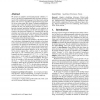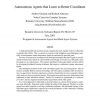663 search results - page 129 / 133 » On the Foundations of Expected Expected Utility |
IR
2006
13 years 7 months ago
2006
Collaborative filtering is a general technique for exploiting the preference patterns of a group of users to predict the utility of items for a particular user. Three different co...
TOCS
2008
13 years 7 months ago
2008
We present an adaptive work-stealing thread scheduler, ASTEAL, for fork-join multithreaded jobs, like those written using the Cilk multithreaded language or the Hood work-stealing...
AAMAS
2004
Springer
13 years 7 months ago
2004
Springer
A fundamental difficulty faced by groups of agents that work together is how to efficiently coordinate their efforts. This coordination problem is both ubiquitous and challenging,...
JSAC
2007
13 years 7 months ago
2007
— The fundamental advantage of peer-to-peer (P2P) multimedia streaming applications is to leverage peer upload capacities to minimize bandwidth costs on dedicated streaming serve...
BC
2004
13 years 7 months ago
2004
Abstract. The neural circuits of birdsong appear to utilize specific time delays in their operation. In particular, the anterior forebrain pathway (AFP) is implicated in an approxi...


